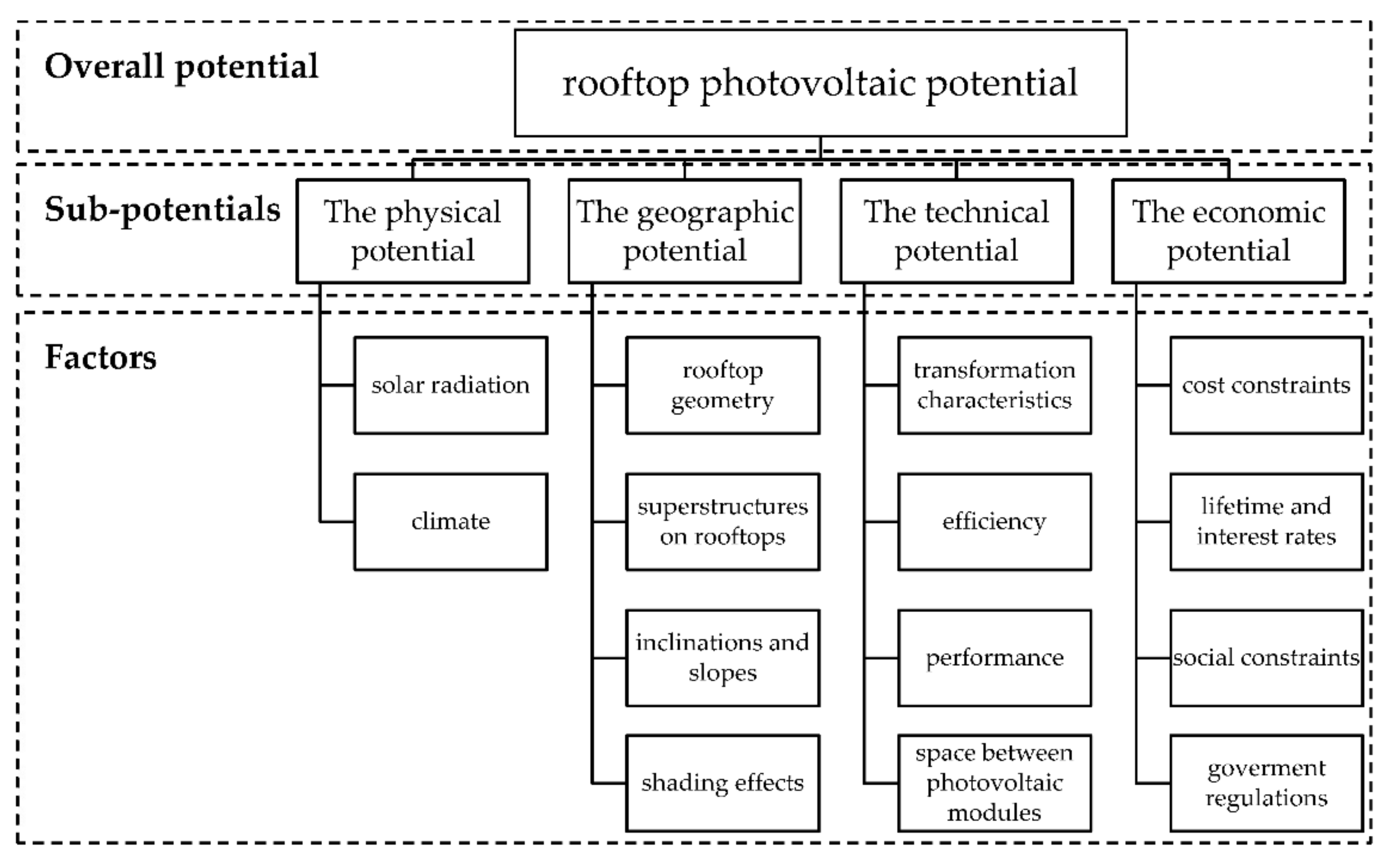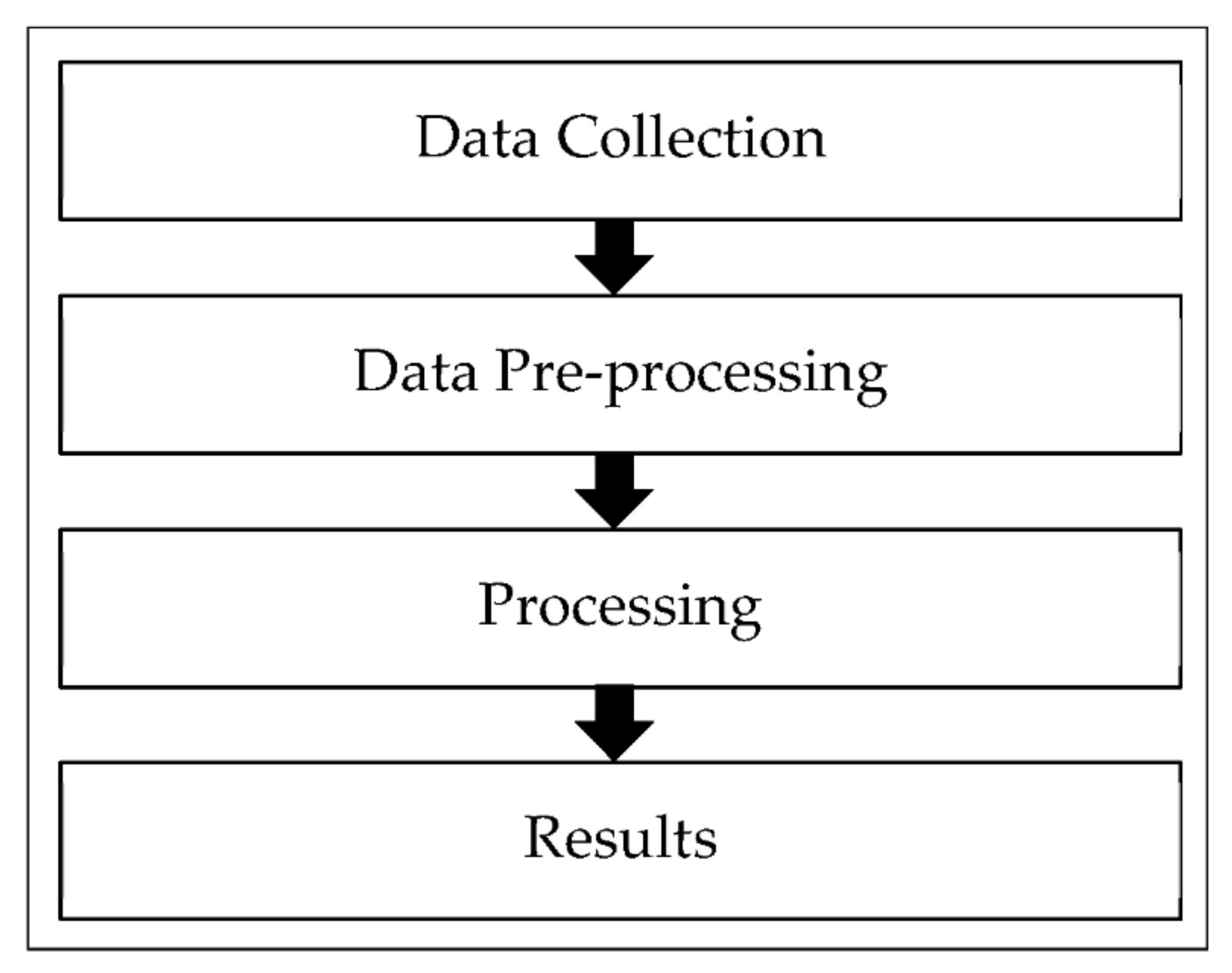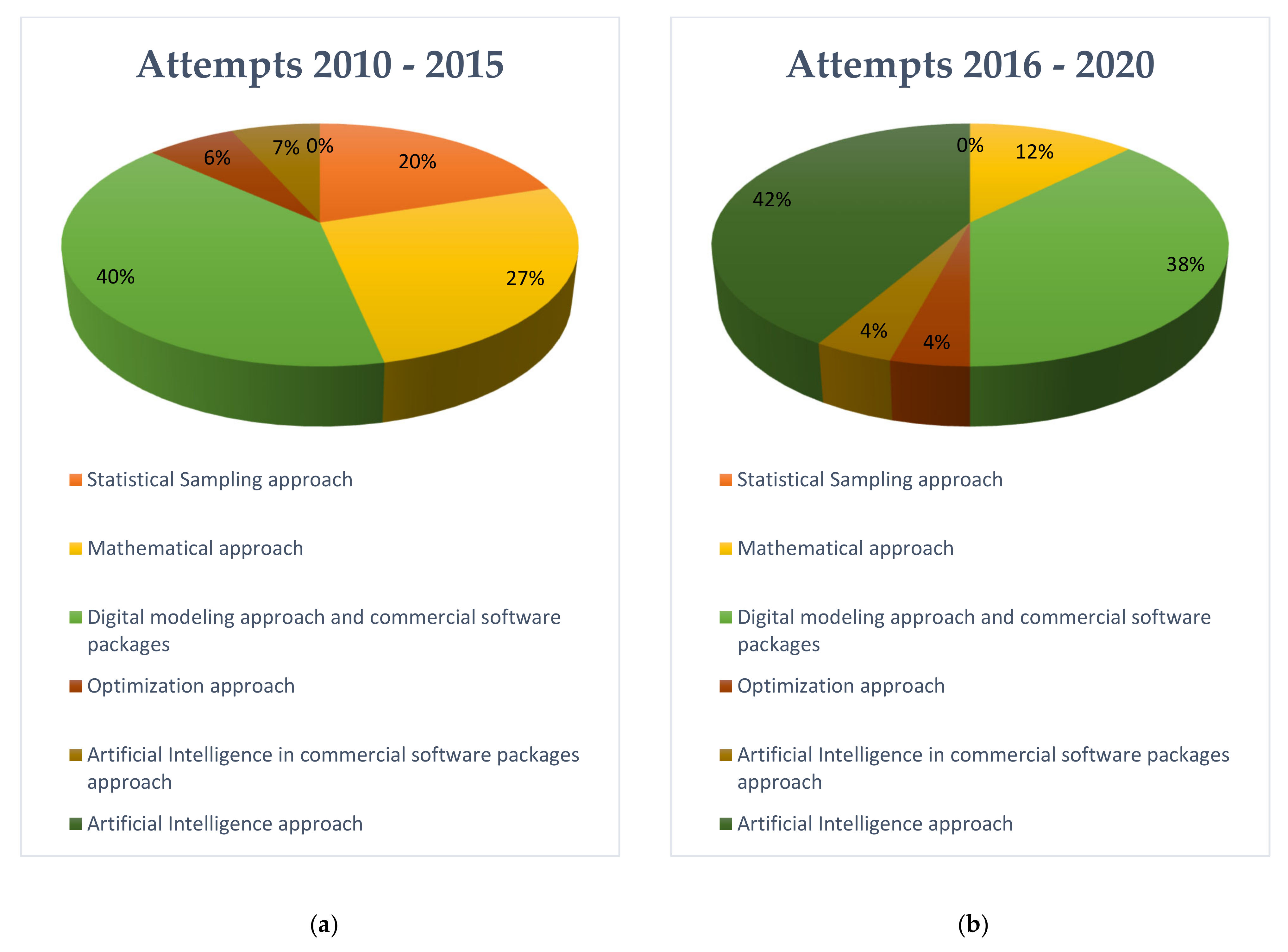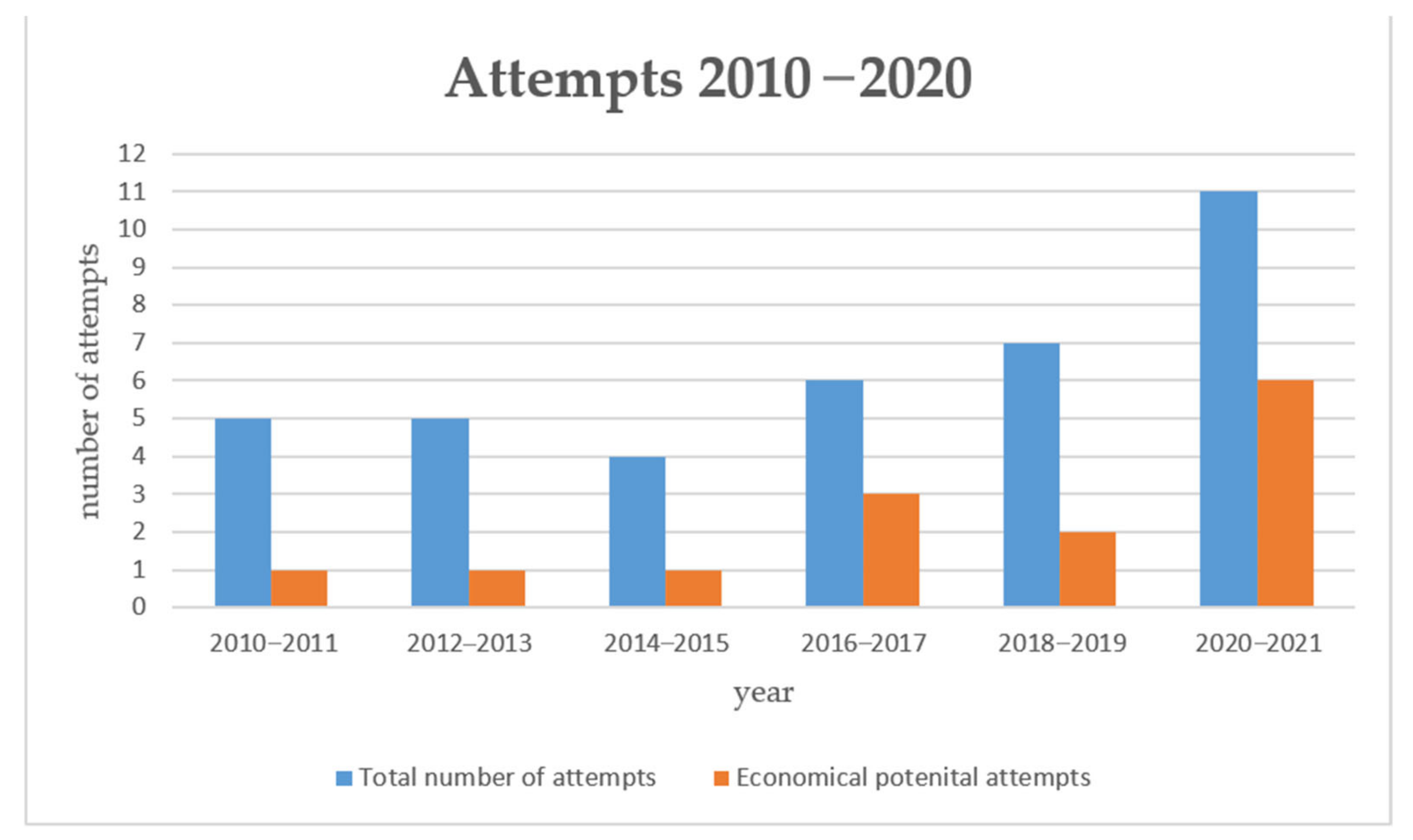The Urban Rooftop Photovoltaic Potential Determination
Abstract
:1. Introduction
2. Materials and Methods
2.1. Sub-Potentials and Their Essential Factors
2.1.1. Physical Potential
2.1.2. Geographic (Urban) Potential
2.1.3. The Technical (Electricity Generation) Potential
2.1.4. The Economic Potential
2.2. Methodologies and Their Approaches
2.2.1. Statistical Sampling Approach
2.2.2. Mathematical Approach
2.2.3. Digital Modeling Approach and Commercial Software Packages
2.2.4. Optimization Approach
2.2.5. Artificial Intelligence in Commercial Software Packages Approach
2.2.6. Artificial Intelligence Approach
3. Results
4. Discussion
5. Conclusions
Author Contributions
Funding
Institutional Review Board Statement
Informed Consent Statement
Data Availability Statement
Conflicts of Interest
References
- Huang, Z.; Mendis, T.; Xu, S. Urban solar utilization potential mapping via deep learning technology: A case study of Wuhan, China. Appl. Energy 2019, 250, 283–291. [Google Scholar] [CrossRef]
- Izquierdo, S.; Rodrigues, M.; Fueyo, N. A method for estimating the geographical distribution of the available roof surface area for large-scale photovoltaic energy-potential evaluations. Sol. Energy 2008, 82, 929–939. [Google Scholar] [CrossRef]
- Sharma, P.; Kolhe, M.; Sharma, A. Economic performance assessment of building integrated photovoltaic system with battery energy storage under grid constraints. Renew. Energy 2020, 145, 1901–1909. [Google Scholar] [CrossRef]
- Mohajeri, N.; Assouline, D.; Guiboud, B.; Bill, A.; Gudmundsson, A.; Scartezzini, J.-L. A city-scale roof shape classification using machine learning for solar energy applications. Renew. Energy 2018, 121, 81–93. [Google Scholar] [CrossRef]
- Schallenberg-Rodríguez, J. Photovoltaic techno-economical potential on roofs in regions and islands: The case of the Canary Islands. Methodological review and methodology proposal. Renew. Sustain. Energy Rev. 2013, 20, 219–239. [Google Scholar] [CrossRef]
- Assouline, D.; Mohajeri, N.; Scartezzini, J.-L. Quantifying rooftop photovoltaic solar energy potential: A machine learning approach. Sol. Energy 2017, 141, 278–296. [Google Scholar] [CrossRef]
- Kouhestani, F.M.; Byrne, J.; Johnson, D.; Spencer, L.; Hazendonk, P.; Brown, B. Evaluating solar energy technical and economic potential on rooftops in an urban setting: The city of Lethbridge, Canada. Int. J. Energy Environ. Eng. 2019, 10, 13–32. [Google Scholar] [CrossRef] [Green Version]
- Ineichen, P. Long Term Satellite Global, Beam and Diffuse Irradiance Validation. Energy Procedia 2014, 48, 1586–1596. [Google Scholar] [CrossRef]
- Walch, A.; Castello, R.; Mohajeri, N.; Scartezzini, J.-L. Big data mining for the estimation of hourly rooftop photovoltaic potential and its uncertainty. Appl. Energy 2020, 262, 114404. [Google Scholar] [CrossRef]
- Ordóñez, J.; Jadraque, E.; Alegre, J.; Martínez, G. Analysis of the photovoltaic solar energy capacity of residential rooftops in Andalusia (Spain). Renew. Sustain. Energy Rev. 2010, 14, 2122–2130. [Google Scholar] [CrossRef]
- Izquierdo, S.; Montañés, C.; Dopazo, C.; Fueyo, N. Roof-top solar energy potential under performance-based building energy codes: The case of Spain. Sol. Energy 2011, 85, 208–213. [Google Scholar] [CrossRef]
- Gooding, J.; Crook, R.; Tomlin, A. Modelling of roof geometries from low-resolution LiDAR data for city-scale solar energy applications using a neighbouring buildings method. Appl. Energy 2015, 148, 93–104. [Google Scholar] [CrossRef] [Green Version]
- Verso, A.; Martin, A.; Amador, J.; Dominguez, J. GIS-based method to evaluate the photovoltaic potential in the urban environments: The particular case of Miraflores de la Sierra. Sol. Energy 2015, 117, 236–245. [Google Scholar] [CrossRef]
- Lukač, N.; Seme, S.; Žlaus, D.; Štumberger, G.; Žalik, B. Buildings roofs photovoltaic potential assessment based on LiDAR (Light Detection and Ranging) data. Energy 2014, 66, 598–609. [Google Scholar] [CrossRef]
- Brito, M.; Gomes, N.; Santos, T.; Tenedório, J. Photovoltaic potential in a Lisbon suburb using LiDAR data. Sol. Energy 2012, 86, 283–288. [Google Scholar] [CrossRef]
- Defaix, P.; van Sark, W.; Worrell, E.; de Visser, E. Technical potential for photovoltaics on buildings in the EU-27. Sol. Energy 2012, 86, 2644–2653. [Google Scholar] [CrossRef] [Green Version]
- Dastoori, K.; Al-Shabaan, G.; Kolhe, M.; Thompson, D.; Makin, B. Impact of accumulated dust particles’ charge on the photovoltaic module performance. J. Electrost. 2016, 79, 20–24. [Google Scholar] [CrossRef]
- Talka, I.; Kolhe, M.; Hyttinen, J. Impact of wind speed on ventilation performance within a container installed with photovoltaic inverter. Renew. Energy 2017, 113, 1480–1489. [Google Scholar] [CrossRef]
- Sharma, A.; Kolhe, M.; Konara, K.; Ulltveit-Moe, N.; Muddineni, K.; Mudgal, A.; Garud, S. Performance assessment of institutional photovoltaic based energy system for operating as a micro-grid. Sustain. Energy Technol. Assess. 2020, 37, 100563. [Google Scholar] [CrossRef]
- Fath, K.; Stengel, J.; Sprenger, W.; Wilson, H.R.; Schultmann, F.; Kuhn, T.E. A method for predicting the economic potential of (building-integrated) photovoltaics in urban areas based on hourly Radiance simulations. Sol. Energy 2015, 116, 357–370. [Google Scholar] [CrossRef]
- Assouline, D.; Mohajeri, N.; Scartezzini, J.-L. Large-scale rooftop solar photovoltaic technical potential estimation using Random Forests. Appl. Energy 2018, 217, 189–211. [Google Scholar] [CrossRef]
- Wu, Y.; Xu, C.; Ke, Y.; Chen, K.; Sun, X. An intuitionistic fuzzy multi-criteria framework for large-scale rooftop PV project portfolio selection: Case study in Zhejiang, China. Energy 2018, 143, 295–309. [Google Scholar] [CrossRef]
- Wu, Y.; Wang, J.; Ji, S.; Song, Z.; Ke, Y. Optimal investment selection of industrial and commercial rooftop distributed PV project based on combination weights and cloud-TODIM model from SMEs’ perspectives. J. Clean. Prod. 2019, 234, 534–548. [Google Scholar] [CrossRef]
- Bergamasco, L.; Asinari, P. Scalable methodology for the photovoltaic solar energy potential assessment based on available roof surface area: Application to Piedmont Region (Italy). Sol. Energy 2011, 85, 1041–1055. [Google Scholar] [CrossRef] [Green Version]
- Bergamasco, L.; Asinari, P. Scalable methodology for the photovoltaic solar energy potential assessment based on available roof surface area: Further improvements by ortho-image analysis and application to Turin (Italy). Sol. Energy 2011, 85, 2741–2756. [Google Scholar] [CrossRef] [Green Version]
- Peng, J.; Lu, L. Investigation on the development potential of rooftop PV system in Hong Kong and its environmental benefits. Renew. Sustain. Energy Rev. 2013, 27, 149–162. [Google Scholar] [CrossRef]
- Lopez-Ruiz, H.G.; Blazquez, J.; Vittorio, M. Assessing residential solar rooftop potential in Saudi Arabia using nighttime satellite images: A study for the city of Riyadh. Energy Policy 2020, 140, 111399. [Google Scholar] [CrossRef]
- Gomez-Exposito, A.; Arcos-Vargas, A.; Gutierrez-Garcia, F. On the potential contribution of rooftop PV to a sustainable electricity mix: The case of Spain. Renew. Sustain. Energy Rev. 2020, 132, 110074. [Google Scholar] [CrossRef]
- Singh, R.; Banerjee, R. Estimation of rooftop solar photovoltaic potential of a city. Sol. Energy 2015, 115, 589–602. [Google Scholar] [CrossRef]
- Singh, R. Approximate rooftop solar PV potential of Indian cities for high-level renewable power scenario planning. Sustain. Energy Technol. Assess. 2020, 42, 100850. [Google Scholar] [CrossRef]
- Lukač, N.; Žlaus, D.; Seme, S.; Žalik, B.; Štumberger, G. Rating of roofs’ surfaces regarding their solar potential and suitability for PV systems, based on LiDAR data. Appl. Energy 2013, 102, 803–812. [Google Scholar] [CrossRef]
- Strzalka, A.; Alam, N.; Duminil, E.; Coors, V.; Eicker, U. Large scale integration of photovoltaics in cities. Appl. Energy 2012, 93, 413–421. [Google Scholar] [CrossRef]
- Rodríguez, L.R.; Duminil, E.; Ramos, J.S.; Eicker, U. Assessment of the photovoltaic potential at urban level based on 3D city models: A case study and new methodological approach. Sol. Energy 2017, 146, 264–275. [Google Scholar] [CrossRef]
- Jakubiec, J.A.; Reinhart, C.F. A method for predicting city-wide electricity gains from photovoltaic panels based on LiDAR and GIS data combined with hourly Daysim simulations. Sol. Energy 2013, 93, 127–143. [Google Scholar] [CrossRef]
- Schunder, T.; Yin, D.; Bagchi-Sen, S.; Rajan, K. A spatial analysis of the development potential of rooftop and community solar energy. Remote. Sens. Appl. Soc. Environ. 2020, 19, 100355. [Google Scholar] [CrossRef]
- Suomalainen, K.; Wang, V.; Sharp, B. Rooftop solar potential based on LiDAR data: Bottom-up assessment at neighbourhood level. Renew. Energy 2017, 111, 463–475. [Google Scholar] [CrossRef]
- Hong, T.; Lee, M.; Koo, C.; Kim, J.; Jeong, K. Estimation of the Available Rooftop Area for Installing the Rooftop Solar Photovoltaic (PV) System by Analyzing the Building Shadow Using Hillshade Analysis. Energy Procedia 2016, 88, 408–413. [Google Scholar] [CrossRef] [Green Version]
- Hong, T.; Lee, M.; Koo, C.; Jeong, K.; Kim, J. Development of a method for estimating the rooftop solar photovoltaic (PV) potential by analyzing the available rooftop area using Hillshade analysis. Appl. Energy 2017, 194, 320–332. [Google Scholar] [CrossRef]
- De Vries, T.N.; Bronkhorst, J.; Vermeer, M.; Donker, J.C.; Briels, S.A.; Ziar, H.; Zeman, M.; Isabella, O. A quick-scan method to assess photovoltaic rooftop potential based on aerial imagery and LiDAR. Sol. Energy 2020, 209, 96–107. [Google Scholar] [CrossRef]
- Nelson, J.R.; Grubesic, T.H. The use of LiDAR versus unmanned aerial systems (UAS) to assess rooftop solar energy potential. Sustain. Cities Soc. 2020, 61, 102353. [Google Scholar] [CrossRef]
- Alhammami, H.; An, H. Techno-economic analysis and policy implications for promoting residential rooftop solar photovoltaics in Abu Dhabi, UAE. Renew. Energy 2020, 167, 359–368. [Google Scholar] [CrossRef]
- Hong, T.; Koo, C.; Park, J.; Park, H.S. A GIS (geographic information system)-based optimization model for estimating the electricity generation of the rooftop PV (photovoltaic) system. Energy 2014, 65, 190–199. [Google Scholar] [CrossRef]
- Fina, B.; Auer, H.; Friedl, W. Cost-optimal economic potential of shared rooftop PV in energy communities: Evidence from Austria. Renew. Energy 2020, 152, 217–228. [Google Scholar] [CrossRef]
- Wiginton, L.; Nguyen, H.; Pearce, J. Quantifying rooftop solar photovoltaic potential for regional renewable energy policy. Comput. Environ. Urban Syst. 2010, 34, 345–357. [Google Scholar] [CrossRef] [Green Version]
- Reames, T.G. Distributional disparities in residential rooftop solar potential and penetration in four cities in the United States. Energy Res. Soc. Sci. 2020, 69, 101612. [Google Scholar] [CrossRef]
- Castello, R.; Roquette, S.; Esguerra, M.; Guerra, A.; Scartezzini, J.-L. Deep learning in the built environment: Automatic detection of rooftop solar panels using Convolutional Neural Networks. J. Phys. Conf. Ser. 2019, 1343, 012034. [Google Scholar] [CrossRef]
- Mainzer, K.; Killinger, S.; McKenna, R.; Fichtner, W. Assessment of rooftop photovoltaic potentials at the urban level using publicly available geodata and image recognition techniques. Sol. Energy 2017, 155, 561–573. [Google Scholar] [CrossRef] [Green Version]
- Bódis, K.; Kougias, I.; Jäger-Waldau, A.; Taylor, N.; Szabó, S. A high-resolution geospatial assessment of the rooftop solar photovoltaic potential in the European Union. Renew. Sustain. Energy Rev. 2019, 114. [Google Scholar] [CrossRef]
- Phap, V.M.; Huong, N.T.T.; Hanh, P.T.; Van Duy, P.; Van Binh, D. Assessment of rooftop solar power technical potential in Hanoi city, Vietnam. J. Build. Eng. 2020, 32, 101528. [Google Scholar] [CrossRef]
- Song, X.; Huang, Y.; Zhao, C.; Liu, Y.; Lu, Y.; Chang, Y.; Yang, J. An Approach for Estimating Solar Photovoltaic Potential Based on Rooftop Retrieval from Remote Sensing Images. Energies 2018, 11, 3172. [Google Scholar] [CrossRef] [Green Version]





| Ref | Data | Location | Location Area (km2) | Roof Area (km2) | Annual Generated Electricity | Demand Coverage (%) | Error (%) | Year |
|---|---|---|---|---|---|---|---|---|
| [2] | GIS Statistical | Spain | 505,990 | 571 | 32 | 2008 | ||
| [10] | Google Earth Statistical | Andalusia (Spain) | 87,597 | 265.52 | 9.73 GWh | 78.89 | 10 | 2010 |
| Ref | Tools | Data | Location | Location Area (km2) | Roof Area (km2) | Annual Generated Electricity | Demand Coverage (%) | Error (%) | Year |
|---|---|---|---|---|---|---|---|---|---|
| [24] | MATLAB and GIS Software | GIS Statistical | Piedmont (Italy) | 25,000 | 43 | 6900 GWh | 28.16 | 1.7 | 2011 |
| [25] | Ortho-image analysis | Georeferenced images | Turin (Italy) | 858 GWh | 10 | 2011 | |||
| [26] | estimate rooftop from ground floor area | Statistical on-site information | Hong Kong | 54 | 5981 GWh | 14.2 | 15 | 2013 | |
| [27] | Nightlight intensity | Statistical Nighttime satellite images | Riyadh (Saudi Arabia) | 185,000 rooftop | 0.7 TWh | 2020 | |||
| [28] | Interpolation algorithm with Matlab ArcGIS—PVGIS | National geographical—Cartographical | Spain | 505,990 | 1134 | 291 TWh | 45 | 2020 | |
| [29] | GIS image analysis micro–macro synthesis | Statistical Google earth | Mumbai (India) | 458.27 | 2190 MW | 20 | 19.4 | 2015 | |
| [30] | mathematical model micro-level simulations in PVSyst | Statistical—land-use and building stock | 13 Indian cities | 17.8 GWp | 2020 |
| Ref | Tools | Data | Location | Location Area (km2) | Roof Area (km2) | Annual Generated Electricity | Demand Coverage (%) | Error (%) | Year |
|---|---|---|---|---|---|---|---|---|---|
| [31] | Rating rooftops Digital elevation model | LiDAR geospatial | Maribor (Slovenia) | 1 | 2.6 | 2013 | |||
| [15] | ArcGIS solar analyst extension tool | LIDAR Statistical | Lisbon (Portugal) | 538 rooftop | 11.5 GWh | 48 | 2012 | ||
| [7] | digital surface model digital elevation model ArcGIS | LiDAR—GIS | Lethbridge (Canada) | 124.3 | 2.73 | 3011 GWh | 38 | 2019 | |
| [20] | 3D city model ArcGIS Radiance Software | Real Estate Office 3D model | Karlsruhe (Germany) | 173 | 930 GWh | 2015 | |||
| [32] | modular simulation INSEL model 3D model | LIDAR | Stuttgart (Germany) | 1.5 | 35 | 2012 | |||
| [33] | INSEL model 3D model SimStadt platform | CityGML | Ludwigsburg (Germany) | 700 | 22.26 | 1318 GWh | 77 | 2017 | |
| [34] | 3D model Daysim simulation | GIS—LiDAR | Cambridge (USA) | 4881.3 kWh | 5.3 | 2013 | |||
| [35] | Normalized Digital Surface Model Digital Terrain Model Digital Surface Model | LiDAR Statistical | Erie County (USA) | 271 | 2020 | ||||
| [36] | Digital surface model ArcGIS | LiDAR statistical | Auckland (New Zealand) | 1364 kWh/m2 | 2017 | ||||
| [37] | Hillshade tool Polygon to Raster tool ArcGIS | Building elevation Statistical | Gangnam-Seoul (South Korea) | 4.903 | 2016 | ||||
| [38] | Hillshade tool from ArcGIS | Building elevation Statistical | Gangnam-Seoul (South Korea) | 4.964 | 1,130,371 MWh | 150 | 2017 | ||
| [39] | quick-scan yield prediction | Aerial imagery GIS-LIDAR | Eindhoven (Netherlands) | 145 rooftop | 145 rooftop | 1070 kWh/kWp | 2020 | ||
| [40] | Digital elevation model | UAS-LIDAR | Phoenix (U.S) | 0.265 | 0.027 | 5089 GWh | 2020 | ||
| [14] | nonlinear efficiency characteristics model | LIDAR | Maribor (Slovenia) | 0.5 | 12 | 2014 | |||
| [41] | GIS-based method Esri ArcGIS software | Urban Planning and Municipalities building-shape data | Khalifa—Zayed (Abu Dhabi) | 23 (Khalifa) | 2 (Khalifa) | 206 GWh (Khalifa) | 20 (Khalifa) | 2020 |
| Ref | Tools | Data | Location | Location Area (km2) | Roof Area (km2) | Annual Generated Electricity | Demand Coverage (%) | Error (%) | Year |
|---|---|---|---|---|---|---|---|---|---|
| [42] | GIS-based optimization model | Statistical on-site information | Seoul Busan-Daejeon (South Korea) | 275.33 kWh per panel (busan) | 2014 | ||||
| [43] | Optimization model | statistical | Austria | 10 GWp | 100 | 2020 |
| Ref | Tools | Data | Location | Location Area (km2) | Roof Area (km2) | Annual Generated Electricity | Demand Coverage (%) | Error (%) | Year |
|---|---|---|---|---|---|---|---|---|---|
| [44] | Feature analyst extraction in ArcGIS | GIS Statistical | Part of Ontario (Canada) | 48,000 | 25 | 6909 GWh | 5 | 15 | 2010 |
| [45] | DeepSolar GIS software | National datasets Statistical | 4 US cities | 395,387 roof | 2020 |
| Ref | Tools | Data | Location | Location Area (km2) | Roof Area (km2) | Annual Generated Electricity | Demand Coverage (%) | Error (%) | Year |
|---|---|---|---|---|---|---|---|---|---|
| [6] | Supervised learning Support Vector Machine algorithm | LiDAR CORINE Land Cover Statistical | Switzerland | 1901 communes | 328 | 17.86 TWh | 28 | 2017 | |
| [4] | Support Vector Machine classification MATLAB Solar radiation GIS | LIDAR | Geneva (Switzerland) | 66,811 roof | 2018 | ||||
| [21] | Machine Learning Random Forest model | LiDAR Digital Orthophoto | Switzerland | 41,285 | 252 | 16.29 TWh | 25.3 | 2017 | |
| [9] | Data mining Machine Learning | LiDAR statistical | Switzerland | 9,600,000 rooftops | 267 | 24 TWh | 40 | 2019 | |
| [1] | U-Net Deep learning | Google Earth | Wuhan (China) | 961 | 17.3 TWh | 9.51 | 2019 | ||
| [47] | Image recognition Machine learning | Geographical building Aerial images | Freiburg (Germany) | 49,573 building | 524 GWh | 2017 | |||
| [48] | Machine learning | Statistical Satellite | EU | 680 TWh | 24.4 | 2019 | |||
| [49] | Artificial intelligence | Statistical Satellite image | Hanoi (Vietnam) | 3359 | 139.4 | 37,591 GWh | 2020 | ||
| [50] | Segmentation Hough transformation | Satellite image | Beijing (China) | 0.678 | 63.78 GWh | 2018 |
Publisher’s Note: MDPI stays neutral with regard to jurisdictional claims in published maps and institutional affiliations. |
© 2021 by the authors. Licensee MDPI, Basel, Switzerland. This article is an open access article distributed under the terms and conditions of the Creative Commons Attribution (CC BY) license (https://creativecommons.org/licenses/by/4.0/).
Share and Cite
Fakhraian, E.; Alier, M.; Valls Dalmau, F.; Nameni, A.; Casañ Guerrero, M.J. The Urban Rooftop Photovoltaic Potential Determination. Sustainability 2021, 13, 7447. https://doi.org/10.3390/su13137447
Fakhraian E, Alier M, Valls Dalmau F, Nameni A, Casañ Guerrero MJ. The Urban Rooftop Photovoltaic Potential Determination. Sustainability. 2021; 13(13):7447. https://doi.org/10.3390/su13137447
Chicago/Turabian StyleFakhraian, Elham, Marc Alier, Francesc Valls Dalmau, Alireza Nameni, and Maria José Casañ Guerrero. 2021. "The Urban Rooftop Photovoltaic Potential Determination" Sustainability 13, no. 13: 7447. https://doi.org/10.3390/su13137447
APA StyleFakhraian, E., Alier, M., Valls Dalmau, F., Nameni, A., & Casañ Guerrero, M. J. (2021). The Urban Rooftop Photovoltaic Potential Determination. Sustainability, 13(13), 7447. https://doi.org/10.3390/su13137447







